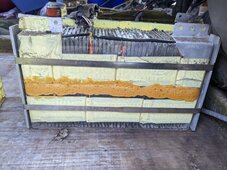Hi folks, I was just reading about the need for a class T fuse with lithium batteries, and believe I understand the concept of why high AIC ratings are needed. What I'm now getting hung up on is, why aren't class T fuses needed at EVERY point where a fuse is needed? For instance, why is a typical automotive blade fuse sufficient for a downstream circuit where say i have 18awg wires powering a small fan. If i short those wires, won't i have the same issue of very high short circuit current from my battery which would weld the fuse and promptly light those tiny wires on fire? Or would even a 200amp (for example) class T fuse blow in that instance before the small downstream wires overheated?
Many thanks in advance and I hope i didn't miss this question being asked elsewhere....
As an add-on, I am using an 88ah 13.8volt Lithium Titanate used EV battery (8p6s altairnano pouch cells) periodically in my camper van. I know LTO is supposed to have very low internal resistance, is a standard class T fuse with 20K Amp capacity still sufficient? At the moment, i have just a few small loads that i connect directly to the battery, like a diesel heater and a 12v outlet plug. These are fused, but i'm guessing those little auto blade fuses are inadequate without a class T somewhere upstream of them?
As another add on, i have a bunch (i think 15-20) more of these batteries that are in various states of disrepair, generally in very low states of charge, with some of the parallel groups likely bad, that i haven't been able to find a local recycler for here in Humboldt County, northern CA. I will make a separate post about these soon, but i'd love to give these away to anyone who might be interested in breaking apart the packs and salvaging good cells. I have attached a photo of one where the assembly is somewhat visible.
Many thanks in advance and I hope i didn't miss this question being asked elsewhere....
As an add-on, I am using an 88ah 13.8volt Lithium Titanate used EV battery (8p6s altairnano pouch cells) periodically in my camper van. I know LTO is supposed to have very low internal resistance, is a standard class T fuse with 20K Amp capacity still sufficient? At the moment, i have just a few small loads that i connect directly to the battery, like a diesel heater and a 12v outlet plug. These are fused, but i'm guessing those little auto blade fuses are inadequate without a class T somewhere upstream of them?
As another add on, i have a bunch (i think 15-20) more of these batteries that are in various states of disrepair, generally in very low states of charge, with some of the parallel groups likely bad, that i haven't been able to find a local recycler for here in Humboldt County, northern CA. I will make a separate post about these soon, but i'd love to give these away to anyone who might be interested in breaking apart the packs and salvaging good cells. I have attached a photo of one where the assembly is somewhat visible.





